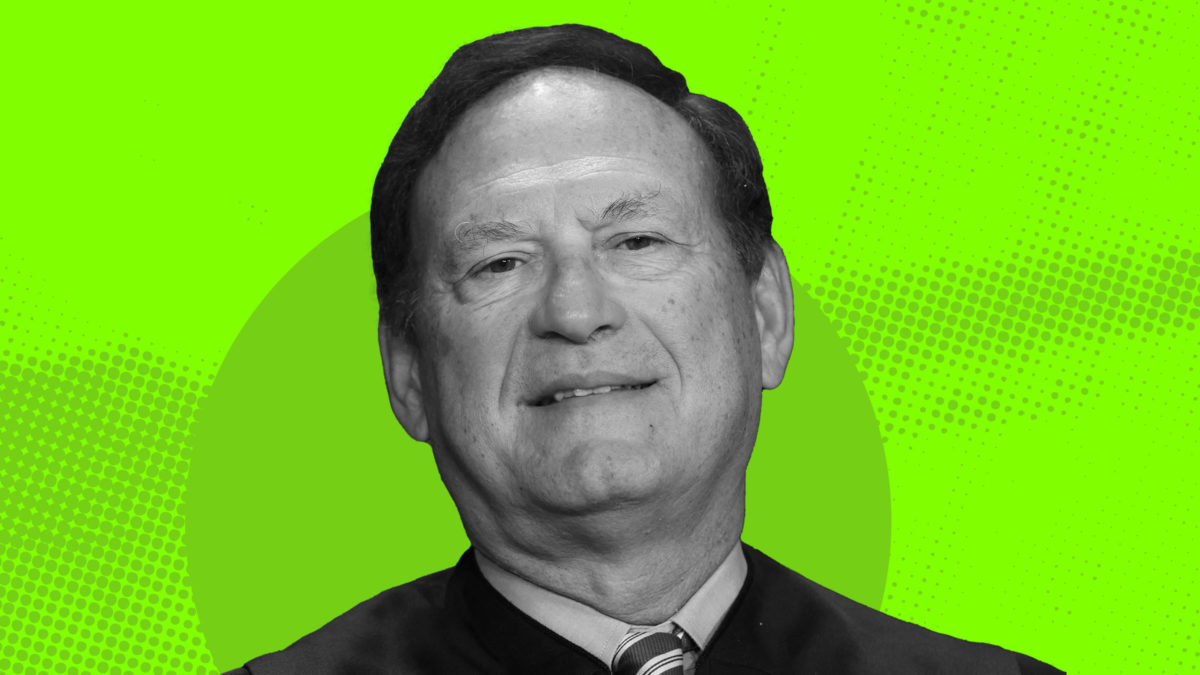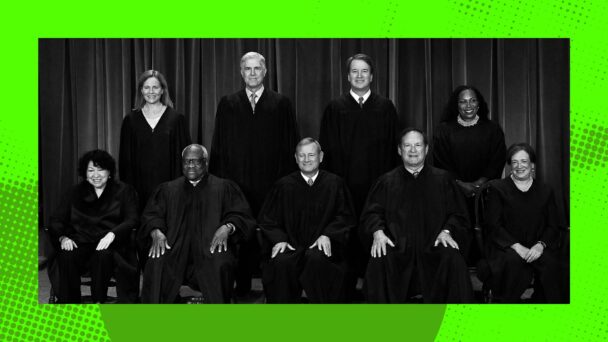On Thursday, the Supreme Court’s conservative supermajority did something very unusual for the Supreme Court’s conservative supermajority: Blessed with an opportunity to further restrict access to abortion care, it instead backed away slowly, declining to issue a merits opinion at all.
Yet the result in Moyle v. United States and Idaho v. United States—two consolidated cases known together as the EMTALA cases—is technical in name only, and papers over sharp disagreements between the justices about Republican lawmakers’ authority to pass the most draconian abortion laws that Jonathan Mitchell can imagine. And their choice to kick the anti-choice can down the road is not evidence of the Court’s moderation on reproductive freedom. It is the work product of a Court controlled by six Republican justices who are keenly aware that a very important election is taking place in the fall, and that the conservative legal movement has a whole lot to gain if they put this case on hold a little longer.
The EMTALA cases are about the gap between two laws related to abortion access: the Emergency Medical Treatment and Labor Act, a federal law that requires hospitals to provide “stabilizing treatment” to patients experiencing medical emergencies, and Idaho’s Defense of Life Act, which criminalizes the provision of abortion care unless it is “necessary” to prevent a pregnant person’s “death.” The question is whether doctors are allowed to perform abortions in that in-between zone when a patient is very, very sick, and terminating the pregnancy is the appropriate treatment, but they are not (yet) guaranteed to die without it. Since Idaho Republicans passed the Defense of Life Act in 2022, this uncertainty has prompted some Idaho hospitals to airlift their sickest patients to other states, where doctors are free to pull patients back from death’s doorstep without fear of facing a prison sentence.
Back in 2022, the Biden administration sued, arguing that the federal EMTALA statute trumps conflicting state law. A federal district court in Idaho agreed, issuing a preliminary injunction that barred the state from enforcing the law while litigation proceeded. But after the Ninth Circuit Court of Appeals declined to vacate the injunction, the Supreme Court took matters into its own hands, staying the injunction and placing the case on its merits docket. Essentially, the justices fast-tracked the case in such a way that they could bypass the courts below—the courts that had, again, sided against Idaho Republicans—and resolve the matter itself.
After the Court heard oral argument in April, the EMTALA cases became one of many blockbuster decisions expected sometime in these frantic weeks before the justices leave Washington for the Fourth of July holiday. But this is where things get weird: On Thursday, the Court issued a one-sentence “opinion” dismissing the cases as “improvidently granted”—a relatively rare maneuver that returns the case to the lower courts to proceed with business as usual. The justices also reinstated the district court’s preliminary injunction, which means that Idaho can’t enforce the law until the legal process has run its course. Legally speaking, after all that, it is as if the year this case spent at the Supreme Court never really happened.
Although the Court’s opinion is designated as “per curiam”—for the Court as a whole—a blizzard of annoyed concurrences and dissents makes clear that all the justices understand that this conflict is delayed, not resolved. Justice Elena Kagan, joined by Justice Sonia Sotomayor and in part by Justice Ketanji Brown Jackson, reiterates her position from oral argument that EMTALA’s requirements pretty clearly preempt Idaho’s law. But in light of how bad the worst-case scenario would be, at this juncture, she seems content to fight another day: Whatever the eventual resolution, Kagan writes, Idaho’s arguments “do not justify, and have never justified” the Court’s bid to “short-circuit” the proceedings in the first place.
The second concurrence, written by Justice Amy Coney Barrett and joined by Chief Justice John Roberts and Justice Brett Kavanaugh, attempts to explain the Court’s punt by pointing to “important concessions” made by both parties. First, she notes that the federal government has stipulated that abortion does not qualify as “stabilizing treatment” for a person in mental health crisis, and that EMTALA does not override existing conscience protections that allow doctors to opt out of personally providing abortion care. Second, she asserts that Idaho has backed off some of the more barbaric interpretations of its law, allegedly clearing the way for doctors to provide care to women who are experiencing specific pregnancy-related medical conditions. This bilateral “narrowing of the dispute,” Barrett concludes, means the justices can step back, let the lower courts work, and get to the case when the time comes.
Barrett, unlike Kagan, does not express skepticism about Idaho’s chances of success on the merits. Instead, she frames her vote to dismiss the case (for now) as a purely practical matter: In light of the parties’ “materially changed” and “evolving” positions, Barrett concludes diplomatically, the Court’s early intervention was a “miscalculation.”

When you do a miscalculation (Photo by Chip Somodevilla/Getty Images)
Jackson, writing only for herself, finds this retreat credulous and embarrassing. She criticizes Barrett, Roberts, and Kavanaugh for treating the “bald representations of Idaho’s counsel” as an “escape hatch,” and points out even if Idaho’s lawyers—who are, incidentally, the far-right Alliance Defending Freedom—are relaxing their positions during litigation, these “convenient rhetorical maneuvers” do not resolve the “plain” statutory conflict. “While this Court dawdles and the country waits, pregnant people experiencing emergency medical conditions remain in a precarious position,” Jackson concludes. “There is simply no good reason not to resolve this conflict now.”
Justice Samuel Alito, joined in part by Justices Clarence Thomas and Neil Gorsuch, is also incensed by the result, but for a different reason: In dissent, the trio essentially calls out the other conservatives for walking right up to the point where they could authorize Republicans to limit their constituents’ medical treatment options to “hoping for the best,” and then getting cold feet. Alito points out that the justices have at their disposal some 1,300 pages of briefing, and heard two hours of oral argument, and have had several months to mull things over. The case, he says, is “as ripe for decision as it has ever been,” echoing Jackson’s impatience. “We have no good reason to change course now.”
The Alito and Jackson opinions both nod at the likeliest explanation for the Court’s last-minute about-face: There is a presidential election going on right now, and public support for abortion rights (63 percent) is a shade higher than public disapproval of the Supreme Court (60 percent). By forming an ungainly alliance with Sotomayor and Kagan, Roberts, Kavanaugh, and Barrett are not taking a substantive position on reproductive rights; Kavanaugh and Barrett, of course, voted to overturn Roe v. Wade two years ago. But what these three Republicans understand is that an(other) anti-choice opinion right now is less valuable than the same anti-choice opinion in nine months or a year from now, but perhaps after Donald Trump wins the White House and/or Republicans take control of Congress. If the legal maneuvering necessary to boost the odds of a Trump victory feels a little awkward in the moment, so be it.
This is simply not a level of patience that Alito, Thomas, or Gorsuch are capable of mustering. In what counts as a pretty scathing critique of the other Republican justices, the dissenters castigate the Court for having “simply lost the will to decide the easy but emotional and highly politicized question that the case presents.” But this dispute is about timing, not substance. Whatever happens on the evening of November 5, it’s not like the Court will be any less able to rubber-stamp Idaho’s law on the morning of November 6.
For all the ink spilled here on the procedural minutiae, both the liberals and the conservatives are clearly preparing for the case to boomerang back to them in the not-so-distant future. Jackson, for example, notes that Barrett’s concurrence does not endorse Idaho’s legal arguments, but does not reject them, either—a sort of jurisprudential holding pattern that would allow Barrett to land the plane when it is more electorally convenient. Alito, as always unable to restrain himself, spends several pages arguing that EMTALA never requires doctors to provide abortion care—an aside that prompts a rejoinder from Kagan, who says this view has “no basis in the statute.” If you were looking for previews of the eventual majority and dissenting merits opinions in this case, Alito and Kagan, respectively, have you pretty well covered.
This is not the first time the Supreme Court has demonstrated political savvy in its docket management. It is not even the highest-profile example from this term, given that, with fewer than six months to go until the election, the conservative supermajority has yet to decide a case about the criminal liability of the Republican presidential candidate who appointed half its members. But in light of everything this Court has already done to curtail reproductive freedom, this resolution of the EMTALA, as Jackson writes, is not a “victory” for pregnant people, but only “delay.” For the liberals these days, delay is often as close to victory as they can hope to get.






